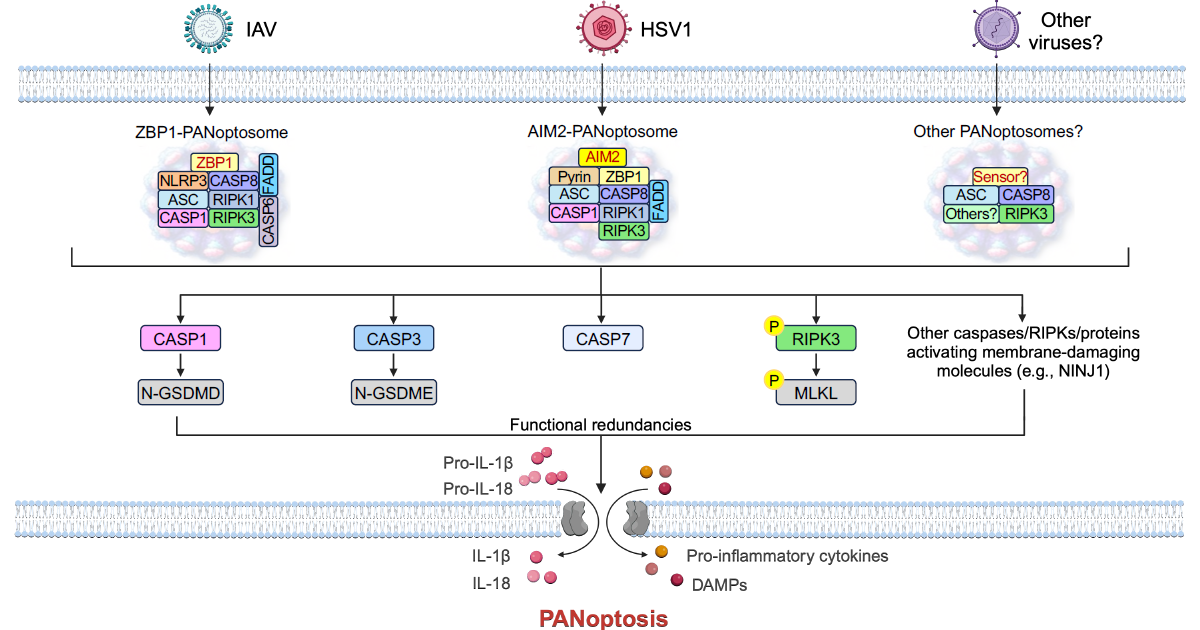- 3.5Impact Factor
- 7.7CiteScore
- 19 daysTime to First Decision
PANoptosis in Viral Infection
This special issue belongs to the section “General Virology“.
Special Issue Information
Dear Colleagues,
Innate immunity provides a critical first line of defence against infections, including viruses. The sensing of viruses by cytosolic innate immune sensors activates signalling pathways that can drive inflammatory cell death, as well as the production of antiviral interferons and proinflammatory cytokines. While inflammatory cell death can be beneficial to clear viral infections, it can also lead to excess inflammation and pathophysiology; therefore, the tight regulation of cell death in response to viral infections is critical.
This Special Issue on PANoptosis in viral infection focuses on viral sensing and the activation of PANoptosis, a unique, lytic, innate immune, and inflammatory cell death pathway that is driven by caspases as well as RIPKs and regulated by PANoptosome complexes. Multiple PANoptosomes have been identified in response to viral infection, including ZBP1- and AIM2-PANoptosomes. This collection of articles will discuss the cellular and molecular mechanisms of PANoptosis and PANoptosomes, providing new insights into therapeutic targets for antiviral therapies and strategies with which to mitigate immunopathogenesis.
Dr. Thirumala-Devi Kanneganti
Guest Editor
Manuscript Submission Information
Manuscripts should be submitted online at www.mdpi.com by registering and logging in to this website. Once you are registered, click here to go to the submission form. Manuscripts can be submitted until the deadline. All submissions that pass pre-check are peer-reviewed. Accepted papers will be published continuously in the journal (as soon as accepted) and will be listed together on the special issue website. Research articles, review articles as well as short communications are invited. For planned papers, a title and short abstract (about 250 words) can be sent to the Editorial Office for assessment.
Submitted manuscripts should not have been published previously, nor be under consideration for publication elsewhere (except conference proceedings papers). All manuscripts are thoroughly refereed through a single-blind peer-review process. A guide for authors and other relevant information for submission of manuscripts is available on the Instructions for Authors page. Viruses is an international peer-reviewed open access monthly journal published by MDPI.
Please visit the Instructions for Authors page before submitting a manuscript. The Article Processing Charge (APC) for publication in this open access journal is 2600 CHF (Swiss Francs). Submitted papers should be well formatted and use good English. Authors may use MDPI's English editing service prior to publication or during author revisions.
Keywords
- Viruses
- Inflammation
- PANoptosis
- PANoptosome

Benefits of Publishing in a Special Issue
- Ease of navigation: Grouping papers by topic helps scholars navigate broad scope journals more efficiently.
- Greater discoverability: Special Issues support the reach and impact of scientific research. Articles in Special Issues are more discoverable and cited more frequently.
- Expansion of research network: Special Issues facilitate connections among authors, fostering scientific collaborations.
- External promotion: Articles in Special Issues are often promoted through the journal's social media, increasing their visibility.
- e-Book format: Special Issues with more than 10 articles can be published as dedicated e-books, ensuring wide and rapid dissemination.

